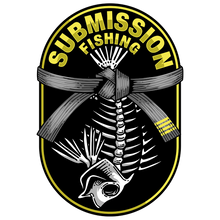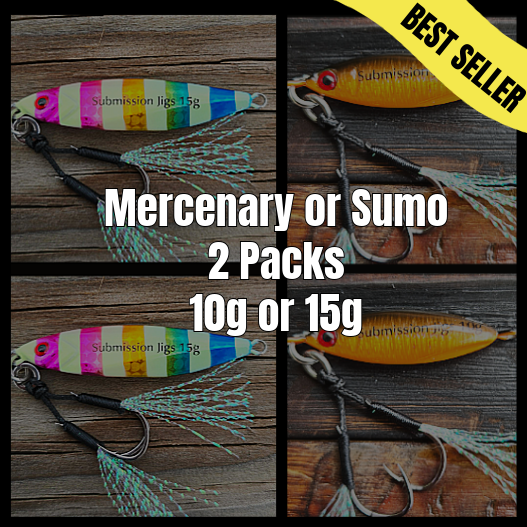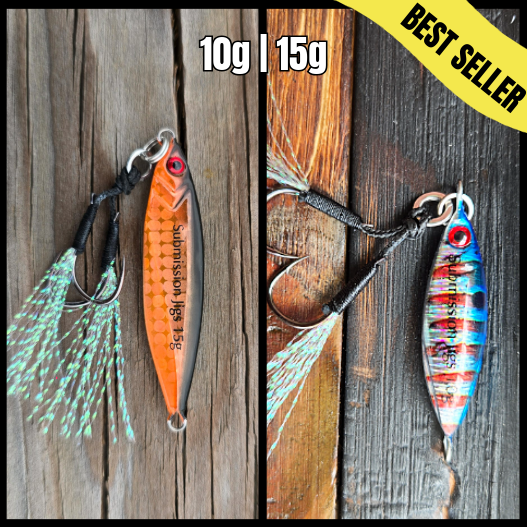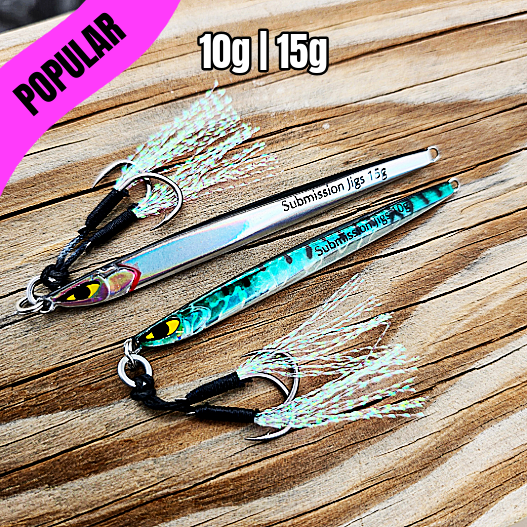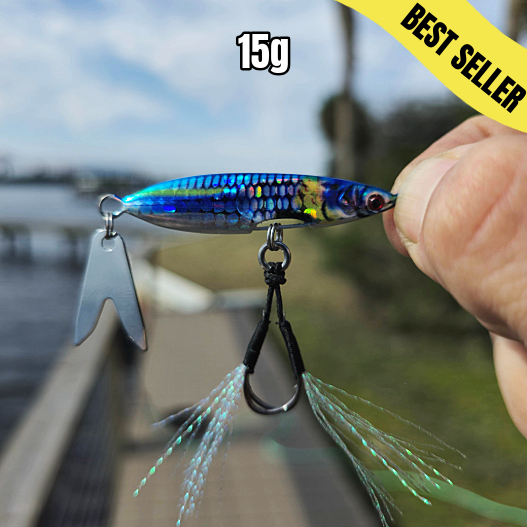Best Slow Pitch Jigging Setup (2025 Guide): Rods, Reels, Line & Jigs
What Is the Best Slow Pitch Jigging Setup? (2025 Edition)
Slow pitch jigging has exploded over the last few years — and for good reason. It’s hands-on, technical, and ridiculously effective for everything from spotted bay bass to tuna and grouper. But here’s the truth: your results depend 100% on your setup.
If you’ve ever wondered:
-
What’s the best slow pitch jigging rod?
-
What reel do I actually need?
-
Do I really need assist hooks?
…this guide will walk you through everything you need — and nothing you don’t — so you can fish smarter, avoid costly mistakes, and land more PBs.
The Best Slow Pitch Jigging Rods (2025 Picks)
Go short, sensitive, and purpose-built.
Forget repurposed boat rods — slow pitch jigging demands a blank designed to load and spring the jig on each lift. Look for:
-
Length: 6–7 feet for precision and comfort
-
Action: Light, parabolic bend for controlled “pitch and fall” cadence
-
Material: High-modulus carbon or graphite for sensitivity + backbone
-
Weight Ratings: Marked in grams (e.g., 100–400g) so you can match jigs to depth/current
-
Features to Look For: Split EVA grips, lightweight construction, and bonus tech like hollow-core or center-line designs for maximum bite detection
Pro Tip: Carry two rods — one for micros and middleweights (10g–40g) and another for heavier work (400g+).
Best Reels for Slow Pitch Jigging in 2025
You want narrow, no-level-wind conventional reels with smooth drags and high line capacity. Why narrow? Less line stacking, better control, and precise drop speed.
Top slow pitch reels for 2025:
-
Accurate Valiant 500N SPJ
-
Daiwa Saltiga 35JH
-
Okuma Tesoro LDJ
-
Shimano Ocea Jigger
-
New “Pro Jigger” reels designed specifically for SPJ
Key features to prioritize:
-
Smooth, powerful drag (stripers to bluefin, you need stopping power)
-
High gear ratio (5:1 sweet spot) for controlled cadence
-
Lightweight frame — your wrists will thank you after 100+ pitches
Line & Leader: The Unsung Heroes
Braid: Go minimum 8-strand (I like 9 myself) PE braided line, 20–30lb for micros and middleweights. Thin diameter = less current drag, true vertical drops, and more sensitivity.
Leader: 3 - 6 feet of mono, 15–80lb depending on target species. Mono adds abrasion and shock resistance around wrecks, rocks, and pilings.
Jigs: Match Weight to Depth & Current
Slow pitch jigs aren’t one-size-fits-all. Follow this rule:
-
1g per foot of water (or 1g per 10ft for micro/lightweight fishing)
-
Light current? Scale down. Heavy current? Scale up.
Our top sellers:
-
Micro Sumo Jigs (10g & 15g) – Compact wobblers perfect for docks, bays, and light inshore work
-
Micro Mercenary Jigs (10g & 15g) – Versatile flutter jigs for cast-and-retrieve or vertical drop
-
Death Blade (20g) – The first slow pitch casting jig; swims on both the fall and the retrieve
-
Javelin (100g & 200g) – Riffled design for erratic flutter and mid-column predators
-
Samurai & Ogre (400g–600g) – Heavy hitters for deep water tuna, grouper, and monster rockfish
Assist Hooks & Rigging: Small Detail, Big Difference
Don’t skip assist hooks — they’re the connection between your jig and your fish. Rigging is a personal decision depending on the conditions and your target species, but one way that works well in many situations is to rig front and rear with short, high-quality cords to boost hookups and reduce snags.
Our go-to: Assist Hooks — saltwater-grade, hand-tied, UV tassels, center-fixed options for Death Blades and micros. For the bigger jigs, the Squid Hooks and Kraken Hooks are the money.
The Slow Pitch Technique (Simplified)
Slow pitch = tease the fish, don’t yank the fish.
-
Drop to the bottom (or mark depth)
-
Quarter- to half-turn reel lifts
-
Let the rod load and spring the jig into a horizontal flutter
-
Most bites happen on the fall — stay alert, stay vertical
Pro Tip: Adjust cadence and weight if current picks up. Staying vertical is everything.
Build Three Setups for Versatility
Serious anglers carry three:
-
Lightweight/Micro: 10–40g (bays, lakes, rivers)
-
Middleweight: 40-300g (coastal wrecks, drop-offs)
-
Heavyweight: 400–1,000g (offshore tuna, deep grouper)
This lets you pivot from dock spotties to offshore monsters without missing a beat.
Why Submission Jigs?
Most brands? Cheap paint, mass-produced shapes, weak hooks. Plastics tear. Bait dies.
Submission Jigs:
-
UV-reactive paint + glow for dirty or deep water
-
Asymmetrical, center-weighted for true slow pitch action
-
Through-wire construction (nose-to-tail durability)
-
Tested by real fishermen, not boardroom suits
Thousands of anglers trust our jigs coast-to-coast:
“21 fish in one trip… 16 on Submission Jigs.” – Danielle
“They outfish Nomads. No doubt.” – Donald
Quick Shopping Checklist
-
Slow pitch rod (10–400g rating, 6–7ft, parabolic action) - match your target species
-
Narrow-spool conventional reel (smooth drag, no level wind)
-
9-strand PE braid (15–30lb) + 15–80lb mono leader
-
Range of jigs: Micros (10g–20g) → Middleweights (100g–200g) → Heavyweights (400g–600g)
-
Assist hooks for front & rear rigging
Ready to Build Your Setup?
Slow pitch jigging isn’t just a technique — it’s a lifestyle. Once you feel that first hit on the fall, you won’t go back to bait.
👉 Shop our full lineup of slow pitch jigs and hooks here and start building the setup that finally matches your ambition.
Want More Tips Like This?
Sign up for our email list and get:
- 🎁 15% off your first order
- 🚀 Early access to new product drops
- 🎥 How-to videos with Mike Muto
